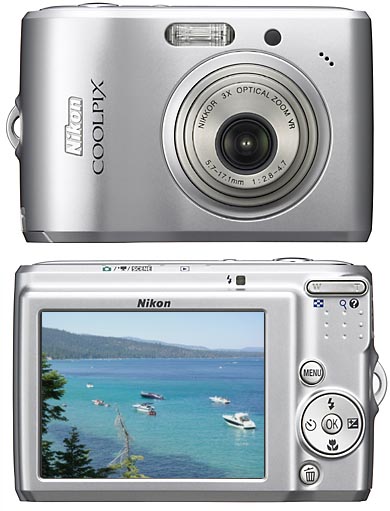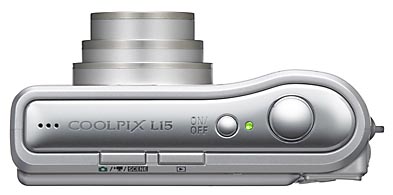|
Nikon Coolpix L15
Inexpensive Nikon LIFE series camera with some nice extras
(by Conrad H. Blickenstorfer)
For oldtimers, the name Nikon still conjures up high-quality, top-end single lens reflex cameras, and Nikon continutes to be very active in that space. However, the company also saw the handwriting on the wall and was one of the early adopters in the digital camera space. As a result, they have gathered a huge amount of expertise with digital imaging, and they also have not shied away from competiting, quite successfully, in the lower cost markets. The name "Coolpix" has become almost synonymous with Nikon digital cameras, and so all carry that brand name, but there are different kinds of Coolpix cameras. One of them is the "LIFE" family. These are designed to be compact, user-friendly cameras that combine good performance and easy operation with the advanced imaging technologies, all at affordable prices.
Introduced in the Fall of 2007, the Nikon Coolpix L15 is a new representative of the LIFE family. It is an inexpensive 8.0 megapixel camera that's quite powerful and flexible. It has a nice, large 2.8-inch LCD screen. Perhaps its most outstanding feature and one that is rarely found in economy cameras that cost so little is full optical VR image stabilization. The difference that can make is amazing.

Getting a lot for the money
If you decide to get this camera, you will not only get a genuine Nikon Coolpix camera, but also one that's as simple and easy to use as it gets. Like it's even less expensive sister L14 model, the L15 isn't one of those ultra-thin fashion statement slivers of a camera but it is certainly handy. It measures 3.6 x 2.4 inches (just a bit more than a credit card) and is 1.2 inches thick. Without batteries it weighs a minuscule 4.4 ounces. Why not just tell how much WITH batteries? Well, because Lithiums are very light, and Alkalines and rechargeable NiMH batteries quite a bit heavier.
In terms of resolution, the L15 is a 8.0 megapixel camera. That's just a bit above the low end these days. But don't feel deprived. 8 megapixel is more than good enough for huge enlargements, and cropping is never an issue; you always end up with enough resolution.
The L15 is strictly a point&shooter, so don't look for manual controls. You do, however, get 16 "scene modes," thos being portrait, landscape, sports, night portrait, party/indoor, beac/snow, sunset, dusk/dawn, night landscape, close-up, museum, fireworks, copy (to take clear pictures of text and print), backlight and panorama.
In the past, inexpensive camers often had limited and nearly useless movie modes. Not the L15. You can record at full 640 x 320 resolution and at a lifelike 30 frames per second, with sound. Recording time is only limited by storage capacity. The one limitation is that you cannot use the optical zoom while shooting movies; digital zoom is available.
This seems to be the year where even inexpensive cameras get additional onboard processing features. Particularly hot is "Face Priority."  What that means is that the camera has the ability too find a face in a picture and then make sure that it is in focus and properly exposed. With the L15, you know face priority works when a double border around the face glows green. In fact, the L15 has an enhanced face recognition function that can recognize five separate faces quickly and efficiently. The picture above shows how the L15 recognizes faces and which one it considers primary.
What that means is that the camera has the ability too find a face in a picture and then make sure that it is in focus and properly exposed. With the L15, you know face priority works when a double border around the face glows green. In fact, the L15 has an enhanced face recognition function that can recognize five separate faces quickly and efficiently. The picture above shows how the L15 recognizes faces and which one it considers primary.
In the buzzword compartment, the L15 incorporate Nikon's EXPEED advanced image processing system for enhanced speed and brilliant color reproduction. A buzzword it may be, but it also works. Unlike film camers, digital cameras benefit greatly from additional onboard electronics.
There are other onboard feature: An In-Camera Red-Eye Fix automatically corrects red eye. And scenes with poor backlight or underexposed faces can be corrected with the D-Lighting function.
The camera comes with 32MB of internal memory, and uses SD cards for storage.
Operation
The Coolpix L15 couldn't be simpler to operate. It has a minimum of controls, and they are all following the commonly accepted current standard for digital cameras. If you've used a digicam before, you'll feel right at home with this Coolpix. On/off and shutter are on top, as well as a playback button and a shooting mode button. The latter is perhaps the only one that is a bit confusing: in playback mode, pushing it gets you back to recording mode. Pushing it in recording mode brings up an onscreen shooting-mode selection menu. On the back there is a four-way navigation ring with an OK button in the center. The ring doubles as a "multi-selector" so you can toggle through flash, focus, time delay, and exposure compensation settings. There are menu and trash buttons and the zoom tocker, and that's it.

What the L15 overs over the L14
At US$179.95, the Coolpix L15 lists for just $30 more than Nikon's other new "LIFE" family camera, the L14. As far as we are concerned, that' be the bext $30 ever spent. Instead of a low-res 2.4-inch display, you get a much larger 2.8-inch LCD with exactly twice the resolution. That make a huge difference when you zoom in. You can actually see if pictures you've taken are sharp. And it is much more pleasant to look at.
You also get image stabilization, something the less expensive L14 doesn't have at all. And it is not just simple digital stabilization that does nothing more than reduce shutter speed and increase sensitivity. No, Nikon sprang for full optical lens-shift image stabilization. Again, the difference can be drastic, especially with zoom shots.
In our experience, most manufacturers add a couple of goodies to more expensive cameras but, inexplicably, also take some away. So you often end up with a higher end camera that lacks some of the stuff the less expensive models have. Nikon did not play this silly game. The only spcs where the L15 lags the L14 are battery life (understandable with the much better screen) and in macro you can only get as close as six inches, and not four as with the L14.
In other areas, things are basic as that is what the low price mandates. There is no image stabilization of any kind. The zoom is the basic 3X optical expected in any digital camera. That can be multiplied by a 4X digital zoom for a maximum of 12X magnificatin. The Zoom-Nikkor glass itself is high quality, as we've come to expect from Nikon. Sensitivity is automatic and can adjust up to ISO 1000, making low-light shotting possible.
Those who like to use their camera for voice recording or who like to add voice annotations to photos are out of luck. The L14 doesn't do that. That is sort of odd as there is a microphone, and sound is recorded with movies.
Overall
Overall, what you get with the Nikon Coolpix L15 is a competent 8.0 megapixel Nikon camera at a very attractive price. It is a point & shooter with no manual control, but you do get 16 shooting modes. The camera is compact and light, fits into just about any pocket, and is ultra-simple to operate.
Even though it is an entry-level camera, it has a good Nikon lens, can shoot VGA movies with sound and at a full 30 frames per second speed, and there are even onboard goodies like face recognition and red-eye reduction. Where this camera excels, and what makes it a better overall deal as its less expensive L14 sister model, is the larger and much higher resolution 2.8-inch LCD and optical lens-shift image stabilization, something that is usually reserved for much more expensive cameras.
We like:
- A real 8.0 megapixel Nikon at a very low price
- Large, superb 2.8-inch LCD with very high resolution
- Optical lens-shift image stabilization
- Very simple to use and operate
- Face recognition mode
- Full speed VGA movies with sound
Not so much:
- No voice recording or sound notes
|